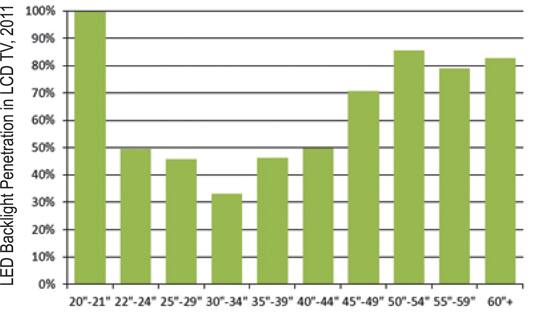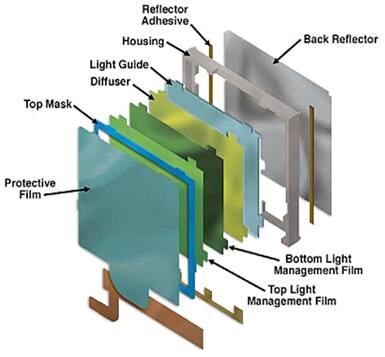Challenges and Solutions for LED Backlighting Design
投稿人:电子产品
2012-12-18
There are many possibilities for backlighting liquid crystal display panels, including incandescent, electroluminescence, fluorescence, LEDs, and woven fiber optics. The selection typically comes down to appearance vs. cost vs. features. Solid-state lighting is the primary choice in LCD backlighting because it has better luminance and power efficiency than cold-cathode fluorescent lamps (CCFL). The main advantages of LED backlighting are low cost and long life.
The earliest LED backlight designs used direct lighting, in which a large number of LEDs are mounted behind the display. These failed to gain market share due to high cost, despite their excellent image quality and ability to perform local dimming. Samsung, followed by other flat-panel makers, then moved to adopt edge-mounted LED backlights and had significant early success, in large part due to the fact that the edge-lit LED backlights enabled extremely thin set designs, in some cases less than 10 mm.
Edge-lit LED backlights allow the set maker to reduce the number of LEDs by concentrating them along the edges. This happened first on all four edges, then moved to two, and eventually to a single short edge. Flat panel television makers have continued to struggle with an LED premium that many consumers are unwilling to pay, especially with continuing rapid erosion of retail prices. In 2011, LED-backlit units accounted for 46 percent of LCD TVs (Figure 1)

LEDs are a good choice because they provide about 50,000 hours of operation, a low operating voltage, good color selection, wide temperature range, and compact size. The LED also provides a predominately fixed voltage drop (Vfwd) over a specified range of drive current levels (Ifwd). However, LED backlighting is not without its challenges. For example, the light provided by LEDs can be uneven. But, if a suitable light pipe or diffuser (Figure 2) is used, the lighting can become uniform. Additionally, for operation across a wide temperature range, the forward current supplied to the LEDs is critical, and must be varied according to the ambient temperature.

When considering the driver for a constant-current-type device, the voltage must be developed to move the current, so it stabilizes when it reaches the desired current level. The stabilization point will be the total forward drop of all the LEDs connected in series. The number of LEDs that could be connected in series is limited by the maximum voltage that could be generated by the LED driver. This generated voltage drives the LEDs to the desired amount of current. However, LED drivers can be a challenge because even in the simplest application of LEDs, users could drive up to three nominal +3 Vfwd LEDs in series by using the +12 V system voltage. The remaining +3 V would have to be reserved for a current limiting resistor. This might be very practical method for low-power LED applications, such as small format LED backlit displays.
To reach standard high brightness and ultra-high brightness requirements for mid- to large-format LCD panels, larger numbers of LEDs will be required, which means higher power. A more sophisticated constant current source approach is needed to efficiently supply power to these LEDs. Today, designers can choose from numerous IC LED drivers or a complete, integrated LED driver board to meet the requirement for high brightness.
For example, the STMicroelectronics STLD40D is a white LED power supply for large display backlights. It can provide an output voltage as high as 37 V and can drive up to 10 white LEDs in series. Alternatively, the Texas Instruments UCC28810 high-brightness LED power controller ideal for low to medium power applications that require PFC and EMC compliance. It controls flyback, buck, or boost converts operating in critical conduction mode. The device features low-start-up and low operating currents.
IC or integrated LED driver board?
There are several key LED driver features to consider when deciding whether to use an integrated circuit to design a custom driver or employ an integrated LED driver board. Some of these include board space, development costs, life cycle support, driver input voltage, driver forward voltage, and interconnection of multiple LEDs. Many of the factory LED backlit panels have the LED backlight configured in multiple parallel banks of series connected LEDs, and you may need to use IC style LED drivers, where the total forward voltage drop of all the LEDs connected in series must not exceed the voltage generated by the chip driver.
It would seem to make more sense to design an LED backlight to reach required brightness, along with meeting optical and thermal performance goals, and then choose an integrated LED driver that has the capability to drive it, rather than to allow the limited voltage capability — an inherent weakness of the chip LED driver — to dictate the backlight design. For example, a panel that uses 24 white LEDs connected in four banks of six each will require 23 W of LED power to achieve1,000 cd/m2. Each LED drops approximately +3 V for a combined drop of +18 V/bank. These banks need four independent constant current sources to drive the panel. Each bank consumes 6 W at 0.33 A drive current for the LEDs. However, driving all of the LEDs in series allows them to be driven by the same current value.
Thermal design considerations also are very important. In an enclosure, an electronic device generating heat requires careful thermal management. LEDs are more sensitive to damage from overheating than CCFTs, so it is necessary to dissipate this operating heat as efficiently as possible. Ineffective thermal management can drastically reduce the operational life of an LED backlight, and subsequently the LCD product. Twenty-four white LEDs, rewired to a single series-connected bank, require only 9 W to achieve 1,000 cd/m2, significantly lowering the heat in the enclosed space.
Still another challenge to implement LED drivers in a design, and one that can cause a “gotcha”, is the lack of standardization in the industry of LED backlight configuration and LED connectivity. Inside the backlight, there are some similarities in the way panel manufacturers configure the LEDs. This configuration tends to be in multiple banks of series-connected LEDs, but that is where the similarities end. Some manufacturers choose a common anode connection, some choose a common cathode configuration, and others choose a separate cathode and anode connection for each bank. This lack of standardization makes it difficult for designers to address the connectivity of LED drivers. The solution provided by some manufacturers is to add flexibility to support any and all of these configurations.
Regardless which backlight retrofit method is employed, thermal management will be a significant challenge for high or ultra-high brightness applications, especially when the display product is in a high operating temperature environment because an LED’s performance and lifetime degrade in high temperatures. For some LED solution suppliers, good thermal performance is more a result of the configuration of the LED’s, proprietary drive techniques, and driver technology than through the use of traditional thermal management techniques such as heatsinking and convection, although these methods could also be employed in extreme applications.
The industry is moving toward standard LED backlighting parts for LCD panels and that will increase the number of stock parts used. As the LED device efficiencies continue to improve, higher brightness levels will be met with factory LED backlit panels and it is anticipated that IC drivers will become “standardized” — in practice if not via recognized standards organization — resulting in lower prices.
Further Reading
- SID 2012 Preview / Backlighting Issue April 2012 Vol. 28, No. 04
- LED backlighting for LCDs, Sharp Microelectronics
- Considerations for LED backlight and driver solutions, Applied Concepts
免责声明:各个作者和/或论坛参与者在本网站发表的观点、看法和意见不代表 DigiKey 的观点、看法和意见,也不代表 DigiKey 官方政策。








